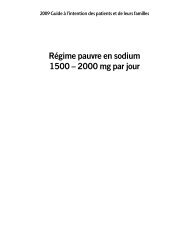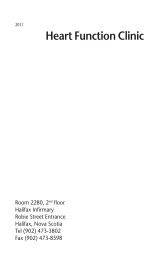Tracheostomy Care At Home
Tracheostomy Care At Home
Tracheostomy Care At Home
Create successful ePaper yourself
Turn your PDF publications into a flip-book with our unique Google optimized e-Paper software.
<strong>Tracheostomy</strong> <strong>Care</strong> <strong>At</strong> <strong>Home</strong>
Contents<br />
Breathing ...............................................................................................................3<br />
What is a <strong>Tracheostomy</strong>?......................................................................................3<br />
Your <strong>Tracheostomy</strong> Tube ......................................................................................4<br />
How Do I <strong>Care</strong> for My Trach?................................................................................5<br />
Cleaning Your Trach Tube ....................................................................................5<br />
Your Routine..........................................................................................................7<br />
Caring for Your Stoma...........................................................................................8<br />
Cleaning Around Your Stoma................................................................................8<br />
Your Routine..........................................................................................................9<br />
Changing Your Trach Tie.......................................................................................9<br />
Clearing Secretions .............................................................................................11<br />
How to Suction ....................................................................................................11<br />
The Suction Machine...........................................................................................12<br />
Speaking..............................................................................................................12<br />
Swallowing...........................................................................................................13<br />
What to Do If........................................................................................................14<br />
Keep Your Secretions Thin..................................................................................15<br />
Emotions..............................................................................................................16<br />
Intimacy ...............................................................................................................16<br />
Protect Yourself from the Flu...............................................................................16<br />
Recipe for Normal Saline (Salt Water).................................................................17<br />
Recipe for Sterile Water ......................................................................................17<br />
Stoma Bib (Knit) ..................................................................................................17<br />
Stoma Shower Shields ........................................................................................18<br />
Stoma Bib (Crochet) ............................................................................................18<br />
Supplies...............................................................................................................18
This booklet tells you about your tracheostomy and how to care for it at<br />
home. Please do not feel that all of it must be read at one time. Your<br />
nurses, therapists and doctors will help you to understand the<br />
information and do the tasks.<br />
Take your time. Write down any questions you might have.<br />
Feel free to talk about your concerns and questions with us.<br />
We are here to help you and your family.<br />
2
It will help you to understand your tracheostomy, if you know more about your<br />
breathing.<br />
Breathing<br />
Air comes into your lungs when you<br />
breathe. Usually air enters your lungs<br />
through your nose and mouth, then<br />
travels down a tube called the<br />
trachea or windpipe to get to the<br />
lungs. Your lungs are the organs for<br />
breathing. As air travels through the<br />
nose, throat and windpipe, it is<br />
warmed, cleaned and moistened.<br />
When you swallow, a small lid<br />
(epiglottis) closes over the windpipe<br />
so that food goes into the food tube<br />
(esophagus), rather than the<br />
windpipe. Air epiglottis esophagus<br />
vocal chords larynx trachea<br />
What is a <strong>Tracheostomy</strong>?<br />
An opening is made into the trachea, or windpipe, to help you breathe. This<br />
opening is called a “stoma”. A tube called a tracheostomy or trach tube, is placed<br />
into the opening. The trach tube allows you to breathe in air directly into your<br />
windpipe instead of through your mouth and nose.<br />
There are many reasons why a tracheostomy is needed. Your doctor has<br />
explained why one is necessary for you. If you do not understand, ask one of us.<br />
Because the air goes straight into the windpipe, your nose can no longer clean,<br />
warm and put moisture in the air you breathe. Also, because the opening (stoma)<br />
is below your vocal cords, you may only be able to talk by covering the opening<br />
of your trach tube. You may find that you need to be very careful swallowing, to<br />
keep food from going into your windpipe. We will talk more about these things<br />
later in the book.<br />
3
Your <strong>Tracheostomy</strong> Tube<br />
To care for your trach tube you will need to learn more about it.<br />
The different parts of a tracheostomy tube are:<br />
1. an outer cannula<br />
2. trach plate<br />
3. an inner cannula<br />
4. an obturator or guide<br />
The outer cannula (1) fits into the trachea and maintains the opening during<br />
healing. The trach-plate (2) is a flat plastic hinge attached to the outer cannula. It<br />
has holes on either side so that ties can be inserted and tied around the neck.<br />
This prevents the tube from falling out.<br />
The inner cannula (3) locks into the outer cannula and can be removed and<br />
cleaned frequently. Cleaning ensures that the airway is clear of mucous. You<br />
may have more than one inner cannula. Check to see which one you should be<br />
using.<br />
The obturator (4) is used only when the entire trach tube is changed. It acts as a<br />
guide when the outer cannula is inserted into the trachea. This reduces irritation<br />
to the trachea wall.<br />
4<br />
4
How Do I <strong>Care</strong> for My Trach?<br />
You or someone you live with will need to learn how to:<br />
• clean the trach tube<br />
• care for your stoma<br />
• clear secretions from your lungs<br />
• change the trach ties<br />
We will help you every step of the way.<br />
Cleaning Your Trach Tube<br />
Cleaning the inner cannula of your trach tube is an important task. It should be<br />
done at least once a day, or more often if needed, to keep it clean and free of<br />
secretions.<br />
To clean the inner cannula you will need:<br />
• 2 bowls (margarine containers work well) or disposable cups Ð one for<br />
cleaning, one for rinsing.<br />
• Hydrogen peroxide solution.<br />
• Long pipe cleaner, cotton tipped applicator or a trach brush.<br />
• Sterile water (see recipe for sterile water, page 17).<br />
First you need to prepare things:<br />
1. Wash your hands well.<br />
2. In the 1st bowl, make hydrogen peroxide solution. (Pour 1/2 cup of<br />
sterile water and 1/2 cup of hydrogen peroxide into one bowl).<br />
3. In the 2nd bowl, pour only sterile water.<br />
4. Cough or suction if needed. This clears the airway of secretions.<br />
Take a few deep breaths.<br />
5
Now you are ready to clean the inner cannula!<br />
1. Loosen the inner cannula.<br />
2. Hold the outer cannula with one<br />
hand. With the other hand turn the<br />
inner cannula to your right to<br />
unlock.<br />
3. Remove the inner cannula by<br />
steadily pulling it down and toward<br />
your chest until it is out.<br />
4. Place the inner cannula in the<br />
peroxide solution.<br />
5. Use a pipe cleaner folded double,<br />
an applicator stick or trach brush to<br />
gently clean the inner cannula and<br />
to remove mucous and dried<br />
secretions.<br />
6
6. Now place it in the bowl of plain sterile water<br />
and rinse well.<br />
7. Shake off excess water. Do not dry it.<br />
Moisture will make the inner cannula<br />
slide back in easily.<br />
8. Reinsert the inner cannula. Keep the<br />
curved portion facing downward.<br />
9. Lock the inner cannula into position.<br />
10. Wash bowls thoroughly and leave to dry in a<br />
clean place. If using a trach brush soak it in<br />
hydrogen peroxide, rinse with sterile water and<br />
leave to dry. Throw away pipe cleaners or<br />
applicator sticks and paper cups.<br />
11. Wash your hands.<br />
Your Routine<br />
____________________________________<br />
____________________________________<br />
____________________________________<br />
____________________________________<br />
____________________________________<br />
____________________________________<br />
7
Caring for Your Stoma<br />
Clean the stoma, or area of skin around the outer cannula at least once a day,<br />
and as often as you need to keep it clean and dry.<br />
You will need:<br />
• A clean facecloth (used only for trach care). Sterile water (normal saline if the<br />
skin is red or sore).<br />
• Q-tips or cotton tipped applicators.<br />
• Trach dressings if you are using them.<br />
Cleaning Around Your Stoma<br />
1. Choose a comfortable position such as sitting in front of a mirror.<br />
2. Remove the old dressing.<br />
3. Wash your hands well.<br />
4. Wet your facecloth with sterile water. Gently cleanse the outer cannula and<br />
skin around it. Q-tips may be used for “hard-to-get” areas under the trach<br />
plate.<br />
5. Look closely at your stoma site. Call your doctor if you notice any redness,<br />
swelling, irritation, bleeding, green discharge or food.<br />
6. Put on ointment, if you are using one, with an applicator stick.<br />
7. Put on a new dressing with the open ends up.<br />
5. 4<br />
6.<br />
You change your trach dressing or clean your stoma whenever it is soiled, or at<br />
least once every day.<br />
Gloves are an option if you want them. Washing your hands is not. Wash them<br />
before and after every time you do something with your trach, even if you choose<br />
to wear gloves.<br />
8
Your Routine<br />
____________________________________<br />
____________________________________<br />
____________________________________<br />
____________________________________<br />
____________________________________<br />
____________________________________<br />
____________________________________<br />
____________________________________<br />
____________________________________<br />
____________________________________<br />
____________________________________<br />
____________________________________<br />
____________________________________<br />
____________________________________<br />
____________________________________<br />
____________________________________<br />
Changing Your Trach Tie<br />
You will need to remove and replace your trach tie at least every 2nd or 3rd day,<br />
and more often if it becomes soiled.<br />
You will need:<br />
• Twill tape<br />
• Scissors<br />
• A helper<br />
9
To change your trach tie:<br />
1. Cut a piece of twill tape long enough to go<br />
around your neck twice. Leave some extra<br />
for tying. Cut the ends on an angle.<br />
Remove trach dressing.<br />
2. Cut and remove the old trach ties. We<br />
suggest that you have someone hold<br />
your trach when you change the ties<br />
because it is possible to cough out the<br />
trach tube.<br />
3. Insert one end of the trach tie through the<br />
opening on one side of the trach plate.<br />
4. Pull the 2 ends of the trach tie together so<br />
they are even.<br />
5. Wrap the ties around your neck and insert<br />
the end of the tie that is closest to your<br />
neck through the opening on the other side<br />
of the trach plate.<br />
6. Tie both ends together in a firm knot on the<br />
side of your neck. Do not tie a bow<br />
because it may come undone. One finger<br />
should fit between the ties and your<br />
neck. Put your new trach dressing on with<br />
the open ends up.<br />
7. We suggest that in the morning and/or<br />
evening, that you combine cleaning your<br />
inner cannula, caring for your stoma and<br />
changing your trach tie all at the same<br />
time. With practice, it will take 10 minutes.<br />
Trach dressings are not needed but may<br />
prevent skin irritation and keep your<br />
clothing dry.<br />
10
Clearing Secretions<br />
Suctioning of the trachea removes secretions from your airway when you cannot<br />
cough them up. Suctioning should be done only when needed, to make<br />
breathing easier. The need to suction is different from person to person. Some<br />
people need to suction often while others rarely or never need to suction.<br />
You will need:<br />
• Suction machine<br />
• Suction catheter (tube) Ð the right size for your trach<br />
• Sterile water (see recipe for Sterile Water, page 17)<br />
• A bowl or disposable cup<br />
• Mirror<br />
• Clean gloves<br />
Now you are ready to suction!<br />
How to Suction<br />
1. Wash your hands well.<br />
2. Open the catheter package and<br />
connect catheter to the suction<br />
machine tubing. Turn on the suction<br />
machine.<br />
3. Put on gloves.<br />
4. Moisten the catheter by dipping it<br />
into a clean container of sterile<br />
water.<br />
5. Sit comfortably in front of a mirror.<br />
Take at least 5 deep breaths.<br />
6. Insert the catheter. Make sure your<br />
thumb is off the opening on the adaptor.<br />
Guide the catheter into the<br />
tracheostomy tube about 4 or 5 inches.<br />
11
7. Place your thumb on and off the<br />
opening on the adaptor to apply<br />
suction as you pull out the catheter in<br />
a rotating (turning) motion.<br />
8. Rinse the catheter of secretions by<br />
suctioning a small amount of sterile<br />
water.<br />
9. If needed, repeat this procedure. Allow<br />
yourself time to catch your breath.<br />
10. If you need to suction deeper, point the catheter in the direction you wish to<br />
suction, either to the left or right. Insert the catheter until you meet<br />
resistance, draw back about 1/2 inch, then suction as above. When that side<br />
is clean, point the catheter to the other side and repeat until you sound clear.<br />
11. Discard the suction catheter when done.<br />
The Suction Machine<br />
1. Empty and clean the collection bottle at least once every 24 hours. The<br />
suction tubing should be rinsed after every use by suctioning water through<br />
the tubing.<br />
2. Every 3 days, soak the tubing and the bottle in enough vinegar and water<br />
solution (1 cup vinegar to 4 cups water) to cover, for 1/2 hour. Rinse very<br />
well with tap water.<br />
3. <strong>At</strong> least once every month, replace with new tubing.<br />
Speaking<br />
Being able to speak is very important to all of us. Speech takes place by air<br />
moving through the vocal cords in our windpipe as we breathe out. Your<br />
tracheostomy is below your vocal cords therefore most of the air that you breathe<br />
out goes through your trach tube. Some air may pass by your tube and through<br />
your vocal cords. The amount of speech that you are able to make depends on<br />
how much air reaches your vocal cords.<br />
There are a number of ways for people who have tracheostomies to regain their<br />
ability to speak.<br />
12
Some examples are:<br />
• Take a deep breath and plug your trach tube as you attempt to speak while<br />
breathing outward. If your trach tube has a cuff it needs to be deflated<br />
when you want to speak.<br />
• A cuffless or fenestrated trach tube (a tube that has a hole) allows more air to<br />
pass through the vocal cords.<br />
• A Passey Muir trach speaking valve can be placed on the end of your trach<br />
tube.<br />
• Esophageal speech if you have had a laryngectomy.<br />
• An electronic speech device.<br />
There may be other things to help you. Let your nurse<br />
• know if you wish to see a speech pathologist before you<br />
• leave the hospital.<br />
Swallowing<br />
Swallowing food and liquid may be troublesome for a few people with<br />
tracheostomies.<br />
Some tips to prevent problems with swallowing are:<br />
1. Sit upright to eat.<br />
2. Eat slowly.<br />
3. Chew your food well.<br />
4. Focus on your swallowing.<br />
5. Tilt your chin down and in as you swallow.<br />
If you are having problems avoid foods with seeds and ground meats such as<br />
hamburger. Remember that liquids are often harder to swallow than foods that<br />
are in gel form.<br />
If you notice food or liquids in your cough secretions let your doctor know<br />
immediately.<br />
13
Safety<br />
It is important to know that you can no longer swim and you should avoid going<br />
out on boats. You would not be able to prevent water from entering your airway.<br />
What to Do If...<br />
You Have A Hard Time Breathing<br />
• You may have secretions in your trach tube. You can either take the inner<br />
cannula out, clean and replace it, or cough hard and suction yourself if<br />
coughing does not work.<br />
• You may have secretions in your windpipe beyond the trach tube. Again, try<br />
coughing. If that does not work, suction yourself.<br />
• If you are often having a hard time breathing, you may need a medication<br />
such as Ventolin¨. It makes it easier for you to breathe and for secretions to<br />
come up. Ask your doctor.<br />
• If your secretions are thick, sticky and/or hard to cough out, consider steps to<br />
make them thinner (see Keep Your Secretions Thin, page 15).<br />
• You may have an infection. If your secretions increase in quantity and change<br />
color, contact your doctor.<br />
You Simply Can’t Breathe Through Your Tube<br />
It is unlikely that this will happen, but if it does it is either because the tube has<br />
slipped out of position (See Your Trach Tube Comes Out, page 14) or, more<br />
likely, you have coughed up secretions that are plugging your tube.<br />
Once again, stay calm!<br />
• Take out your inner cannula.<br />
• If that does not work, cut the ties and take out your tube (see Your Trach<br />
Tube Comes Out) and cough hard or suction yourself through your stoma.<br />
• Consider steps to make your secretions less thick (see Keep Your Secretions<br />
Thin, page 15).<br />
Your Trach Tube Comes Out<br />
Don’t Panic! Stay calm. Your stoma will stay open. It may help to tilt your head<br />
back to keep the stoma opening larger. Think about your own personal plan of<br />
action that you developed for situations in which you need assistance.<br />
14
1. Cut the ties and if you know how, put the tube back in. Use the same<br />
motion you use to put your inner cannula in. Tie it in place.<br />
2. If you do not know how to put the tube back in, go to the nearest hospital<br />
emergency department, call your Family Doctor to come put it in or go to<br />
your Family Doctor’s Office.<br />
3. Most likely you won’t, but if you should have trouble breathing you can hold<br />
(or have someone hold for you) a suction catheter placed about 2 inches<br />
inside your stoma and breathe through it until you can get the tube back in.<br />
Keep Your Secretions Thin<br />
40 - 60% relative humidity in your home is recommended. This can be measured<br />
by a humidstat which is available in most hardware stores. You want to keep<br />
your secretions thin so that you can cough them out easily and avoid suctioning.<br />
Before your tracheostomy, your nose acted as an air conditioner by filtering and<br />
humidifying the air you breathe. After surgery, the air that enters your stoma is<br />
dry and unfiltered. Dry air can cause plugs of mucus to form and clog your<br />
airways. These plugs provide a place for bacteria to grow and may cause<br />
infection. These conditions make your secretions thick and hard to cough out,<br />
and may make breathing more difficult for you. There are several things you can<br />
do to prevent your secretions from getting thick.<br />
• Drink 6 to 8 glasses of fluids, preferably water, a day (check with your doctor).<br />
• Keep a humidifer running beside your bed at night.<br />
• If you can afford them or you have insurance, ask about “artificial noses” or<br />
heat moisture exchangers. Respiratory therapists will know about them.<br />
• If your secretions are thick, hard to cough out or “pluggy”, you need more<br />
humidity. One possibility would be to try 1/2 hour of normal saline from a<br />
nebulizer (compressor or ultrasonic) 4 times a day. Sometimes Ventolin¨ in the<br />
normal saline helps. Ask your doctor.<br />
• If you try these, and you are still having problems, you may need humidity for<br />
longer periods by 24 hour humidifier (compressor or ultrasonic). Check with<br />
your nurse or respiratory therapist about purchasing a machine.<br />
• If you are still having problems, ask a nurse or a respiratory therapist to teach<br />
you how to instill your lungs with normal saline.<br />
• Sleeping in a cool room at night may help to keep your airways moist.<br />
• Mouthcare is also very important. Rinsing with normal saline or plain water is<br />
helpful.<br />
15
• It is important to follow the instructions for cleaning that come with the<br />
humidification machine. Clean the mask and hose with mild soap and water<br />
and rinse with boiled, cooled water. Air dry.<br />
Emotions<br />
It is not unusual for a person to have a variety of emotions before surgery, while<br />
in the hospital, or even after returning home. These are normal reactions. People<br />
have different ways of dealing with these feelings. Getting away for a short trip,<br />
or visiting friends or relatives may be helpful. Some people find that “mingling<br />
with other people”, doing church work, or returning to their job helps to lift their<br />
spirits. It is helpful to speak with another person who has a tracheostomy - ask<br />
your nurse. It is important for you to explore your feelings and identify what<br />
makes you feel better.<br />
Surgery may be a different experience physically and emotionally. <strong>At</strong> a time like<br />
this it is often helpful to talk about your feelings with someone you know or<br />
someone who is trained to help.<br />
Intimacy<br />
With a tracheostomy, sometimes people are afraid they will become unattractive<br />
or unloveable. It helps to remember that people are loved for their entire self Ð<br />
not for appearance of the lower neck. Try not to make the mistake of placing too<br />
much importance on such a small part of you.<br />
It sometimes takes awhile to adjust to physical change. Be patient with yourself<br />
and your loved ones. Often when people go through a difficult experience like<br />
this, it helps to talk about your feelings and encourage your partner or family to<br />
do the same.<br />
Protect Yourself from the Flu<br />
• Get a flu and pneumonia shot every fall if you are not allergic. Check with your<br />
doctor.<br />
• Avoid crowded spaces and people with the flu.<br />
• Stay 3 feet away from your friends during flu season.<br />
• <strong>Care</strong>givers should wear a mask if they have a flu or a cold.<br />
16
Stoma/Trach Covers<br />
When you are out you should wear some type of stoma/trach cover to prevent<br />
dirt and dust from entering your airway. These are available at most drug stores<br />
or can be made (see patterns at end of booklet).<br />
Recipe for Normal Saline (Salt Water)<br />
Buy sodium chloride tablets at the drug store. Drop 2 tablets into 222 mls hot<br />
boiled water (or “spring water”) and cover tightly. Allow to dissolve, then shake to<br />
disperse. Place in a sterile jar you can cover. Refrigerate. Good for 4 weeks in<br />
the fridge.<br />
Recipe for Sterile Water<br />
To make sterile water:<br />
Boil water for 15 minutes in a covered pot. Let it cool. This frees it from bacteria.<br />
To store sterile water:<br />
1. Place clean jars and tops in a large pan of water.<br />
2. Heat water to boiling. Boil for 15 minutes.<br />
3. Remove jars from water. Place on a clean towel to cool.<br />
4. Pour sterile water into jars and seal.<br />
5. Store in refrigerator for up to 2 days.<br />
Stoma Bib (Knit)<br />
Materials:<br />
Coats “Red Heart” Lustre Sheen Knit and Crochet Yarn 579 100% acrylic<br />
Size 12 Knitting needles<br />
Directions:<br />
1. 1st row - knit<br />
2. 2nd row - K.I.W. over K 2 tog. Repeat. Knit last stitch. Work second row until<br />
desired length.<br />
17
3. K. 18 stitches in pattern. Cast off 14 stitches in center. K. 18 stitches in<br />
pattern. Continue in pattern on one side, at the same time decreasing at neck<br />
edge by knitting 2 together every row until 3 stitches remain. Cast off.<br />
4. Finish other side, using remaining 3 stitches to make cord by knitting desired<br />
length. Put loop on other side to tie. OR: Cast off 3 stitches and use crochet<br />
hook to make cord and loop.<br />
Stoma Shower Shields<br />
A commercial latex shower shield can help to keep your airway free from water<br />
while showering.<br />
Stoma Bib (Crochet)<br />
Materials:<br />
Coats “Red Heart” Lustre Sheen Knit and Crochet Yarn 579 100% Acrylic<br />
No. 9 or 3.50 crochet hook<br />
Directions:<br />
1. Make a loose chain 7 inches long (33 chains).<br />
2. Yarn over hook; place hook through the 2 top loops of the third chain; yarn<br />
over hook, draw through; (3 loops on hook); year over, pull through 2 loops;<br />
yarn over; insert hook in next chain and continue to end of row.<br />
3. Chain 2 stitches to turn; crochet in every shain to end of row, chain 2.<br />
Repeat until piece measures 6 inches.<br />
4. Chain 2; crochet into 13 chains; chain 2, turn, skip one chain; crochet to the<br />
last 2 stitches, skip 1 chain; crochet 1; chain 2, turn. Continue, decreasing<br />
1 stitch on each side until 1 chain remains on hook. Make a chain 12<br />
inches long; fasten off.<br />
5. Fasten yarn on left side; chain 2. Crochet into 13 chains and decrease as<br />
for right side to 1 chain on hook. Chain 15 and fasten to form a loop. Single<br />
crochet around neck edge; fasten off.<br />
Supplies<br />
There are some supplies you will need to keep close at hand. It is the<br />
responsibility of the nursing staff, or team discharging you from the hospital, to<br />
provide you with a list of those supplies and where you can obtain them. We<br />
have put together a list for you that your nurse, or team, could use as a checklist.<br />
18
We suggest that you get as many as possible from the same source as a<br />
“package”, and that you shop around for the best deal.<br />
As a general rule, supplies need to be stored in a clean, dry area, preferably a<br />
cupboard that is used only for the purpose of storing supplies.<br />
Some possible sources for your supplies are Pharmasave in the hospital,<br />
Medigas <strong>At</strong>lantic, Vitalaire, Shoppers Drug Mart and Lawtons <strong>Home</strong> Health<br />
Centres and Lifecare Respiratory Services (Gama Distributing).<br />
Notes<br />
__________________________________<br />
__________________________________<br />
__________________________________<br />
__________________________________<br />
__________________________________<br />
__________________________________<br />
__________________________________<br />
__________________________________<br />
__________________________________<br />
__________________________________<br />
__________________________________<br />
__________________________________<br />
__________________________________<br />
__________________________________<br />
__________________________________<br />
__________________________________<br />
19
Notes<br />
__________________________________<br />
__________________________________<br />
__________________________________<br />
__________________________________<br />
__________________________________<br />
__________________________________<br />
__________________________________<br />
__________________________________<br />
__________________________________<br />
__________________________________<br />
__________________________________<br />
__________________________________<br />
__________________________________<br />
__________________________________<br />
__________________________________<br />
__________________________________<br />
__________________________________<br />
__________________________________<br />
__________________________________<br />
__________________________________<br />
__________________________________<br />
__________________________________<br />
20
The QEII promotes a smoke-free and scent-free environment.<br />
Please do not use perfumed products.<br />
Thank you!<br />
Queen Elizabeth II Health Sciences Centre<br />
Halifax, Nova Scotia<br />
Illustrations by: Page 3-LifeART Super Anatomy 1 Images, Copyright © 1994, TechPool<br />
Studios Corp. USA<br />
Photos by: QEII Audio Visual Department<br />
Revised by: Otolaryngology Staff<br />
Designed and Printed by: QEII Audio Visual and Printing Departments<br />
WV85-0244 Rev.01/2004<br />
21







